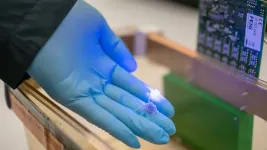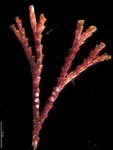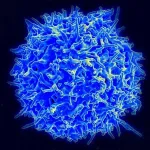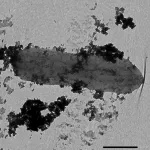(Press-News.org) Gastric bypass surgery is sometimes the last resort for those who struggle with obesity or have serious health-related issues due to their weight. Since this procedure involves making a small stomach pouch and rerouting the digestive tract, it is very invasive and prolongs the recovery period for patients. In a new study, researchers at Texas A&M University have described a medical device that might help with weight loss and requires a simpler operative procedure for implantation.
Researchers said their centimeter-sized device provides the feeling of fullness by stimulating the endings of the vagus nerve with light. Unlike other devices that require a power cord, their device is wireless and can be controlled externally from a remote radio frequency source.
"We wanted to create a device that not only requires minimal surgery for implantation but also allows us to stimulate specific nerve endings in the stomach," said Dr. Sung II Park, assistant professor in the Department of Electrical and Computer Engineering. "Our device has the potential to do both of these things in the harsh gastric conditions, which, in the future, can be hugely beneficial to people needing dramatic weight-loss surgeries."
Further details about their device are published in the January issue of END
Tiny wireless device sheds light on combating obesity
Texas A&M researchers have designed a device that stimulates the endings of the vagus nerve, which is responsible for the regulation of food intake
2021-01-08
ELSE PRESS RELEASES FROM THIS DATE:
Study reveals jellyfish create a 'virtual wall' to enhance performance
2021-01-08
TAMPA, Fla. (Jan. 8, 2021)- New research led by the University of South Florida has uncovered one of the reasons jellyfish have come to be known as the "world's most efficient swimmer." Brad Gemmell, associate professor of integrative biology, found jellyfish produce two vortex rings, which are donut-shaped bodies of fluid underneath their translucent bodies, that spin in opposite directions. They appear as jellyfish squeeze and reopen throughout each swim cycle, providing a "ground effect" force as if they were to be pushing off the seafloor.
The "ground effect" is most widely understood ...
Scientists from St. Petersburg University discovered the virus-like particles in Bryozoa
2021-01-08
Scientists from Russia, Austria, and the USA have discovered virus-like particles in the bacterial symbionts of Bryozoa - a phylum of colonial aquatic invertebrates - filter-feeders dominating in many bottom ecosystems. The research project was planned and supervised by scientists from St Petersburg University. Some of the virus-like particles resemble red blood cells, while others have a sea-urchin-like appearance. Although viruses have never been reported inside symbiotic bacteria in bryozoans, scientists suggest that this "matryoshka doll" may have a prominent effect on the bacterial ...
Measuring racial inequities in COVID-19 testing
2021-01-08
What The Study Did: This study adapted a well-established tool for measuring inequity from economics--the Lorenz curve--to measure racial inequities in COVID-19 testing.
Author: Aaloke Mody, M.D., of the Washington University School of Medicine in St Louis, is the corresponding author.
To access the embargoed study: Visit our For The Media website at this link https://media.jamanetwork.com/
(doi:10.1001/jamanetworkopen.2020.32696)
Editor's Note: The article includes funding/support disclosures. Please see the article for additional information, including other authors, author contributions and affiliations, conflict of interest and financial disclosures, and funding and support.
INFORMATION:
Media ...
Study: Religion, psychology share methods for reducing distress
2021-01-08
CHAMPAIGN, Ill. -- Religious people facing life crises rely on emotion-regulation strategies that psychologists also use, a new study finds. They look for positive ways of thinking about hardship, a practice known to psychologists as "cognitive reappraisal." They also tend to have confidence in their ability to cope with difficulty, a trait called "coping self-efficacy." Both have been shown to reduce symptoms of anxiety and depression.
The new findings are reported in the Journal of Religion and Health.
"It appears that religious people are making use of some of the same tools that psychologists have systematically identified as effective in ...
Ferroptosis resistance in cancer: An emerging crisis of new hope
2021-01-08
Announcing a new publication for BIO Integration journal. In this opinion article the authors Daiyun Xu, Yonghui Lü, Yongxiao Li, Shengbin Li, Zhe Wang and Junqing Wang from Sun Yat-Sen University, Guangzhou, China discuss ferroptosis resistance in cancer.
Ferroptosis is a lethal consequence of accumulated lipid peroxidation catalyzed by ferrous iron and oxygen. This unique cell death process appears to involve many diseases, such as neurodegeneration, ischemia/ reperfusion injury, kidney disease, and a druggable target in therapy-resistant cancers. Ferroptosis may provide hope for ...
We hear what we expect to hear
2021-01-08
Humans depend on their senses to perceive the world, themselves and each other. Despite senses being the only window to the outside world, people do rarely question how faithfully they represent the external physical reality. During the last 20 years, neuroscience research has revealed that the cerebral cortex constantly generates predictions on what will happen next, and that neurons in charge of sensory processing only encode the difference between our predictions and the actual reality.
A team of neuroscientists of TU Dresden headed by Prof Dr Katharina von Kriegstein presents new findings that show that not only the cerebral cortex, but ...
Researchers realize efficient generation of high-dimensional quantum teleportation
2021-01-08
In a study published in Physical Review Letters, the team led by academician GUO Guangcan from University of Science and Technology of China (USTC) of the Chinese Academy of Sciences (CAS) made progress in high dimensional quantum teleportation. The researchers demonstrated the teleportation of high-dimensional states in a three-dimensional six-photon system.
To transmit unknown quantum states from one location to another, quantum teleportation is one of the key technologies to realize the long-distance transmission.
Compared with two-dimensional ...
USTC develops ultrahigh-performance plasmonic metal-oxide materials
2021-01-08
In a study published in Advanced Materials, the researchers from Hefei National Laboratory for Physical Sciences at the Microscale, the University of Science and Technology of China of the Chinese Academy of Sciences, using an electron-proton co-doping strategy, invented a new metal-like semiconductor material with excellent plasmonic resonance performance. This material achieves a metal-like ultrahigh free-carrier concentration that leads to strong and tunable plasmonic field.
Plasmonic materials are widely used in the fields including microscopy, sensing, optical computing and photovoltaics. Most common plasmonic materials are gold and silver. Some other materials ...
Understanding how to improve antibodies targeting OX40 for the treatment of cancer
2021-01-08
Scientists at the University of Southampton's Centre for Cancer Immunology have gained new insight into how the immune system can be better used to find and kill cancer cells.
Working with BioInvent International, a team led by Professor Mark Cragg and Dr Jane Willoughby from the Antibody and Vaccine Group, based at the Centre, have shown that antibodies, designed to target the molecule OX40, give a more active immune response when they bind closer to the cell membrane and can be modified to attack cancer in different ways.
OX40 is a 'co-receptor' that helps to stimulate the production of helper and killer T-cells during an immune ...
How 'Iron Man' bacteria could help protect the environment
2021-01-08
When Michigan State University's Gemma Reguera first proposed her new research project to the National Science Foundation, one grant reviewer responded that the idea was not "environmentally relevant."
As other reviewers and the program manager didn't share this sentiment, NSF funded the proposal. And, now, Reguera's team has shown that microbes are capable of an incredible feat that could help reclaim a valuable natural resource and soak up toxic pollutants.
"The lesson is that we really need to think outside the box, especially in biology. We just know the tip of the iceberg. Microbes have been on earth for billions of years, and to think that they can't do something precludes us from so many ideas and applications," said Reguera, a professor in ...
LAST 30 PRESS RELEASES:
Making lighter work of calculating fluid and heat flow
Normalizing blood sugar can halve heart attack risk
Lowering blood sugar cuts heart attack risk in people with prediabetes
Study links genetic variants to risk of blinding eye disease in premature infants
Non-opioid ‘pain sponge’ therapy halts cartilage degeneration and relieves chronic pain
AI can pick up cultural values by mimicking how kids learn
China’s ecological redlines offer fast track to 30 x 30 global conservation goal
Invisible indoor threats: emerging household contaminants and their growing risks to human health
Adding antibody treatment to chemo boosts outcomes for children with rare cancer
Germline pathogenic variants among women without a history of breast cancer
Tanning beds triple melanoma risk, potentially causing broad DNA damage
Unique bond identified as key to viral infection speed
Indoor tanning makes youthful skin much older on a genetic level
Mouse model sheds new light on the causes and potential solutions to human GI problems linked to muscular dystrophy
The Journal of Nuclear Medicine ahead-of-print tip sheet: December 12, 2025
Smarter tools for peering into the microscopic world
Applications open for funding to conduct research in the Kinsey Institute archives
Global measure underestimates the severity of food insecurity
Child survivors of critical illness are missing out on timely follow up care
Risk-based vs annual breast cancer screening / the WISDOM randomized clinical trial
University of Toronto launches Electric Vehicle Innovation Ontario to accelerate advanced EV technologies and build Canada’s innovation advantage
Early relapse predicts poor outcomes in aggressive blood cancer
American College of Lifestyle Medicine applauds two CMS models aligned with lifestyle medicine practice and reimbursement
Clinical trial finds cannabis use not a barrier to quitting nicotine vaping
Supplemental nutrition assistance program policies and food insecurity
Switching immune cells to “night mode” could limit damage after a heart attack, study suggests
URI-based Global RIghts Project report spotlights continued troubling trends in worldwide inhumane treatment
Neutrophils are less aggressive at night, explaining why nighttime heart attacks cause less damage than daytime events
Menopausal hormone therapy may not pose breast cancer risk for women with BRCA mutations
Mobile health tool may improve quality of life for adolescent and young adult breast cancer survivors
[Press-News.org] Tiny wireless device sheds light on combating obesityTexas A&M researchers have designed a device that stimulates the endings of the vagus nerve, which is responsible for the regulation of food intake





